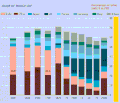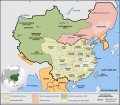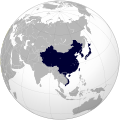Portal:Asia

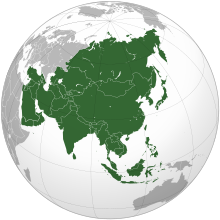 Asia (/ˈeɪʒə/ AY-zhə, UK also /ˈeɪʃə/ AY-shə) is the largest continent in the world by both land area and population. It covers an area of more than 44 million square kilometers, about 30% of Earth's total land area and 8% of Earth's total surface area. The continent, which has long been home to the majority of the human population, was the site of many of the first civilizations. Its 4.7 billion people constitute roughly 60% of the world's population. Asia shares the landmass of Eurasia with Europe, and of Afro-Eurasia with both Europe and Africa. In general terms, it is bounded on the east by the Pacific Ocean, on the south by the Indian Ocean, and on the north by the Arctic Ocean. The border of Asia with Europe is a historical and cultural construct, as there is no clear physical and geographical separation between them. A commonly accepted division places Asia to the east of the Suez Canal separating it from Africa; and to the east of the Turkish straits, the Ural Mountains and Ural River, and to the south of the Caucasus Mountains and the Caspian and Black seas, separating it from Europe. Since the concept of Asia derives from the term for the eastern region from a European perspective, Asia is the remaining vast area of Eurasia minus Europe. Therefore, Asia is a region where various independent cultures coexist rather than sharing a single culture, and the boundary between Europe is somewhat arbitrary and has moved since its first conception in classical antiquity. The division of Eurasia into two continents reflects East–West cultural differences, some of which vary on a spectrum. (Full article...) Featured articleThe Byzantine navy was the naval force of the Byzantine Empire. Like the state it served, it was a direct continuation from its Roman predecessor, but played a far greater role in the defence and survival of the state than its earlier iteration. While the fleets of the Roman Empire faced few great naval threats, operating as a policing force vastly inferior in power and prestige to the army, command of the sea became vital to the very existence of the Byzantine state, which several historians have called a "maritime empire". The first threat to Roman hegemony in the Mediterranean Sea was posed by the Vandals in the 5th century, but their threat was ended by the wars of Justinian I in the 6th century. The re-establishment of a permanently maintained fleet and the introduction of the dromon galley in the same period also marks the point when the Byzantine navy began departing from its late Roman roots and developing its own characteristic identity. This process would be furthered with the onset of the early Muslim conquests in the 7th century. Following the loss of the Levant and later Africa, the Mediterranean was transformed from a "Roman lake" into a battleground between the Byzantines and a series of Muslim states. In this struggle, the Byzantine fleets were critical, not only for the defence of the Empire's far-flung possessions around the Mediterranean basin, but also for repelling seaborne attacks against the imperial capital of Constantinople itself. Through the use of the newly invented "Greek fire", the Byzantine navy's best-known and feared secret weapon, Constantinople was saved from several sieges and numerous naval engagements resulted in Byzantine victories. (Full article...) Selected Country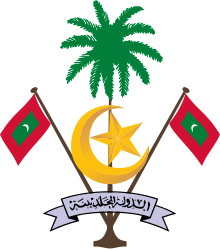 The Maldives, officially the Republic of Maldives, and historically known as the Maldive Islands, is a country and archipelagic state in South Asia in the Indian Ocean. The Maldives is southwest of Sri Lanka and India, about 750 kilometres (470 miles; 400 nautical miles) from the Asian continent's mainland. The Maldives' chain of 26 atolls stretches across the equator from Ihavandhippolhu Atoll in the north to Addu Atoll in the south. The Maldives is the smallest country in Asia. Including the sea, the territory spans roughly 90,000 square kilometres (35,000 sq mi), with a land area of 298 square kilometres (115 sq mi). The Maldives is one of the world's most geographically dispersed sovereign states, and the smallest Muslim country by land area. With a population of 515,132 in the 2022 census, it is the 2nd least populous country in Asia and the ninth-smallest country in the world by area, but also one of the most densely populated countries in the world. (Full article...) Featured biographyTengku Amir Hamzah (February 1911 – 20 March 1946) was an Indonesian poet and National Hero of Indonesia. Born into a Malay aristocratic family in the Sultanate of Langkat in North Sumatra, he was educated in both Sumatra and Java. While attending senior high school in Surakarta around 1930, Amir became involved with the nationalist movement and fell in love with a Javanese schoolmate, Ilik Sundari. Even after Amir continued his studies in legal school in Batavia (now Jakarta) the two remained close, only separating in 1937 when Amir was recalled to Sumatra to marry the sultan's daughter and take on responsibilities of the court. Though unhappy with his marriage, he fulfilled his courtly duties. After Indonesia proclaimed its independence in 1945, he served as the government's representative in Langkat. The following year he was killed in a social revolution led by the PESINDO (Pemuda Sosialis Indonesia), and buried in a mass grave. Amir began writing poetry while still a teenager: though his works are undated, the earliest are thought to have been written when he first travelled to Java. Drawing influences from his own Malay culture and Islam, as well as from Christianity and Eastern literature, Amir wrote 50 poems, 18 pieces of lyrical prose, and numerous other works, including several translations. In 1932 he co-founded the literary magazine Poedjangga Baroe. After his return to Sumatra, he stopped writing. Most of his poems were published in two collections, Nyanyi Sunyi (1937) and Buah Rindu (1941), first in Poedjangga Baroe then as stand-alone books. (Full article...) General imagesThe following are images from various Asia-related articles on Wikipedia. Featured pictureThe Dharmaraya Swamy Temple located in Bangalore is known for being the place where the Bangalore Karaga festival takes place. It is the only festival that is brought about in the temple
Did you know...
Updated: 6:33, 14 February 2024 In the news
Related portalsMajor Religions in Asia Middle East Central Asia and Caucasus Indian Subcontinent Southeast Asia East Asia Selected panoramaAlong the River During the Qingming Festival is a painting from China's Song Dynasty that captures the daily life of people from the period at the capital, Bianjing, today's Kaifeng. As an artistic creation, the piece has been revered, and court artists of subsequent dynasties have made several re-interpretive replicas. The painting is famous because of its geometrically accurate images of boats, bridges, shops, and scenery. Because of its fame, it has been called "China's Mona Lisa". TopicsCategoriesAssociated WikimediaThe following Wikimedia Foundation sister projects provide more on this subject:
More portalsShortcuts to this page: Asia portal • P:ASIA Purge server cache |










